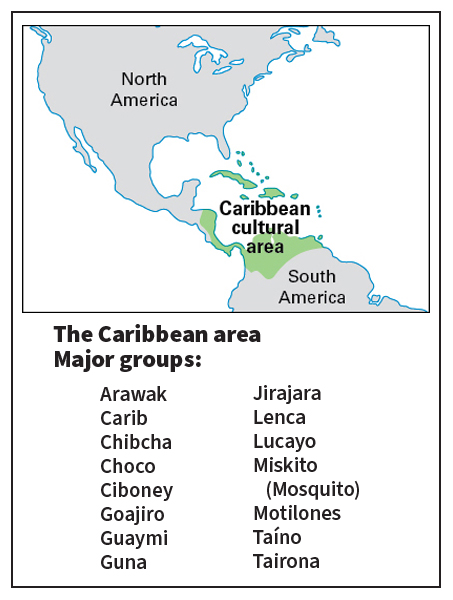Taíno << TY noh >> were a group that lived in a broad region of the northern Caribbean, including much of what is now Cuba and the islands of the Bahamas, Hispaniola, Jamaica, and Puerto Rico. The Taíno spoke a now extinct language in the Arawak language family. Taíno people were the first Native Americans encountered by Christopher Columbus after he arrived in the Americas in 1492. Until that time, Europeans and Native Americans did not know of each other’s existence.

The Taíno grew cassava, maize, peanuts, chili peppers, pineapples, and other crops. For meat, they fished, gathered shellfish, and hunted manatees, sea turtles, birds, and the hutia, a large Caribbean rodent.
The Taíno lived in houses made of wood, vines, and straw. Many dwellings clustered around a central clearing or plaza to form large villages. A chief called a Cacique << kah SEE keh >> ruled over several villages and the surrounding territory. The caciques, either male or female, inherited their position but had limited power and authority. Taíno villages, like those of other Arawak groups, competed with one another in a ceremonial game called batey. It was played with a rubber ball on courts lined with standing slabs of stone.
A medicine man or bohique played a central role in Taíno religious life. Religious activities included the ceremony of the cohoba. In this ceremony, the bohique and caciques inhaled hallucinogenic powders made from the seed of the Cohobana tree. The powders gave the shaman visions, in which he consulted ancestors in the supernatural world.
The Taíno were the first Americans to experience the hardships of European contact, conquest, and colonization. Most Taíno died from disease, warfare, and forced labor under Spanish colonists. However, geneticists believe that some individuals in modern Caribbean populations have some Taíno ancestry. Some elements of Taíno culture survive in the Caribbean region. In addition, Europeans adopted many Taíno words for things they first encountered in the Americas. English words of Taíno origin include canoe, hammock, hurricane, iguana, maize, manatee, papaya, and tobacco.
